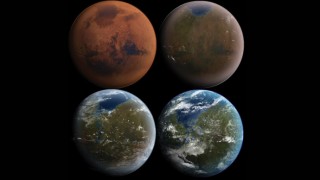
The Defense Advanced Research Projects Agency (DARPA) is considering the possibility of terraforming the inhospitable Martian landscape, with the aid of genetically modified organisms. The Pentagon’s research division said it was now possible to modify the conditions of other worlds to make them more accessible to human life.
“For the first time, we have the technological toolkit to transform not just hostile places here on Earth, but to go into space not just to visit, but to stay,” explained the deputy director of DARPA’s Biological Technologies Office, Alicia Jackson.
If human beings are ever to colonize Mars, outside of artificial structures, the Red Planet’s climate would need to undergo dramatic alterations. The Martian surface is frequently battered by dust storms. This is exacerbated by its thin atmosphere and cold temperatures, with average temps sitting at around -122 degrees Fahrenheit.
According to Motherboard, this could all change. DARPA is currently focusing its attention towards creating genetically engineered organisms to turn Mars into a hospitable, human-friendly planet. In order to do this, DARPA would need to increase the planet’s average temperatures and improve its atmosphere. To thicken the atmosphere, however, researchers would need to litter the planet’s surface with photosynthesizing algae, bacteria and plants.
DARPA has even developed images of what Mars’ terraformed surface would look like. Speaking at a biotechnology conference, Jackson produced various artistic depictions of the terraforming project, while discussing the path to, more quickly, building genetically modified organisms.
Jackson explained that there were between 30 million and 30 billion organisms on our fair planet. “I want to use any organism that has properties I want—I want to quickly map it and quickly engineer it,” explained Jackson.
In attempting to overcome current obstacles in the creation of genetically engineered organisms, her team has developed a piece of software called DTA GView. DTA GView is designed to provide scientists with a more “actionable” database of genetic information. “With this, the goal is to, within a day, sequence and find where I can best engineer an organism,” she concluded.
While Jackson and company aim to terraform other planets, the technology could also yield GM organisms that help with disaster relief efforts, both natural and man-made. Mars may be inhospitable and barren, but there are also plenty of spaces on Earth that are equally unwelcoming.
However, the idea of colonizing other planets with GM organisms may conflict NASA’s approach. It remains the job of Catherine Conley, NASA’s planetary protection officer, to ensure no harmful, Earth-borne contaminates are unleashed unto the galaxy. The Office of Planetary Protection was set up, in part, to prevent “… biological contamination of explored environments that may obscure our ability to find life elsewhere - if it exists.”
